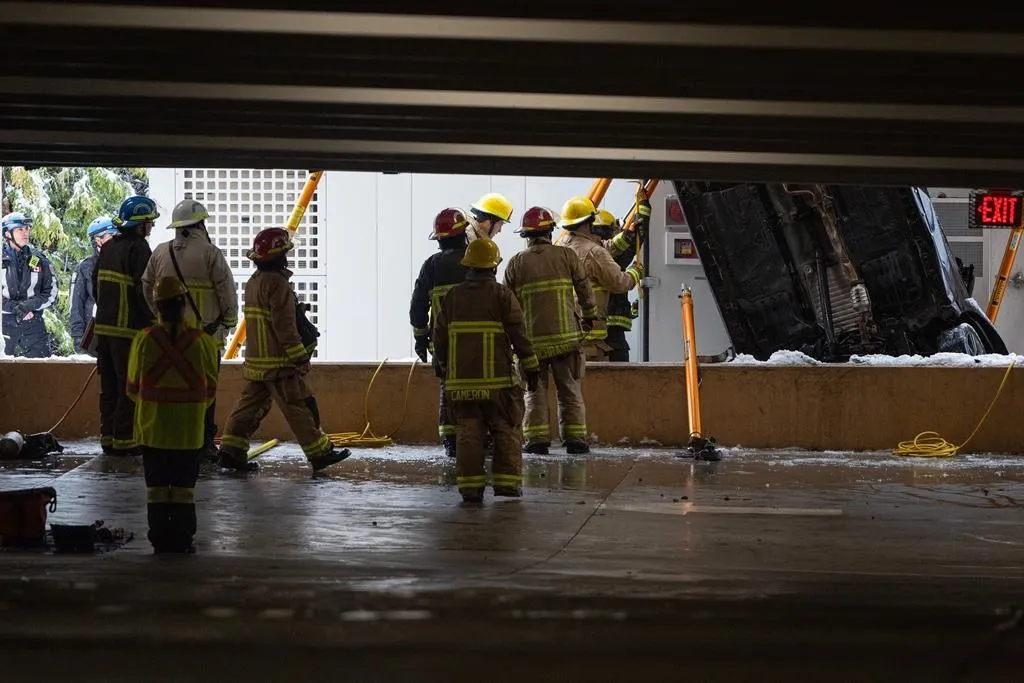
In a devastating incident at the University of British Columbia (UBC), a driver tragically lost their life after their vehicle plunged through a concrete barrier in a multi-storey parkade. The accident occurred on the morning of January 17, 2024, and despite the efforts of emergency services, the driver did not survive the incident. The situation highlights the severe dangers posed by structural failures in parkades and the challenges faced by rescue teams in such hazardous conditions.
The Incident: A Descent into Tragedy
At approximately 9:30 a.m. on January 17, 2024, emergency responders were called to a scene at the UBC campus near Fraser Hall, located at the intersection of Thunderbird Boulevard and Wesbrook Mall. The accident involved a vehicle that had crashed through a concrete barrier on the second floor of a parkade, causing it to fall “nose-first” to the ground below.
The University of British Columbia parkade, like many others on university campuses, is designed to provide convenient parking for students, faculty, and visitors. However, accidents such as this one underscore the potential risks associated with multi-storey structures, particularly when the integrity of barriers or other safety measures fails.
Emergency Response and Complex Rescue Efforts
Responding to the tragic scene were multiple units from Vancouver Fire Rescue Services (VFRS), including a significant number of emergency vehicles. Capt. Matthew Trudeau, spokesperson for VFRS, described the rescue as a “complex” operation, especially given the challenging weather conditions. Heavy snow had been falling, making the rescue efforts even more perilous.
A large piece of concrete, part of the structural barrier, had fallen onto the vehicle, further complicating the rescue. The weight of the concrete beam created additional hazards for rescue personnel, who had to work carefully to extricate the driver from the wreckage. The situation was made even more dangerous by the proximity of a high-voltage area, with a battery-powered storage box located dangerously close to the crash site.
Structural Hazards and Safety Concerns
The precarious nature of the scene added to the complexity of the situation. The concrete barrier, still hanging precariously from the second floor of the parkade, posed a significant risk of further collapse. Firefighters had to secure the area to prevent additional debris from falling and to ensure the safety of both the rescue teams and the public.
The vehicle itself was in a precarious position, further heightening the danger to rescue crews. According to Capt. Trudeau, such an accident, involving both the structural failure of a barrier and the challenging rescue conditions, was unprecedented in their experience. Despite the high degree of complexity, Vancouver Fire Rescue Services had managed to successfully extricate the driver by noon.
The Aftermath: A Community in Mourning
Once the driver was removed from the wreckage, they were immediately transported to a nearby hospital, where they were pronounced dead at the scene. The identity of the driver has not been released, and further investigations are underway to determine the exact cause of the crash.
As a result of the accident, UBC issued an update, informing the public that drivers with vehicles parked in the affected lot could retrieve their vehicles after the area had been stabilized. Campus security and the RCMP were present to ensure the safety of those retrieving their vehicles and to manage any potential hazards in the area.
UBC’s Response to the Incident
In light of this tragic event, UBC has expressed its deepest condolences to the family of the deceased and is working closely with emergency responders to understand the circumstances surrounding the incident. The university has also taken steps to address the structural concerns highlighted by the accident and will be reviewing safety protocols for its parking facilities.
Emergency Services Praise for Rescue Efforts
Despite the tragic outcome, Vancouver Fire Rescue Services and other emergency personnel were praised for their swift response and dedication to safely managing such a hazardous situation. The complex nature of the rescue, combined with the unique challenges presented by the snowstorm and structural issues, showcased the expertise and professionalism of the emergency teams.
Conclusion: A Call for Enhanced Safety Measures
This unfortunate event serves as a sobering reminder of the potential risks posed by structural failures in multi-storey parking garages. It also highlights the need for ongoing safety assessments, particularly in university settings where large numbers of people rely on these facilities daily. As investigations continue, it is imperative that steps are taken to ensure that similar incidents are prevented in the future.
Moving forward, UBC and other institutions should prioritize structural integrity and safety measures, particularly in areas with significant traffic and high-stakes risks. Enhanced safety protocols, regular inspections, and improved emergency response plans can help mitigate the impact of such tragedies in the future.
